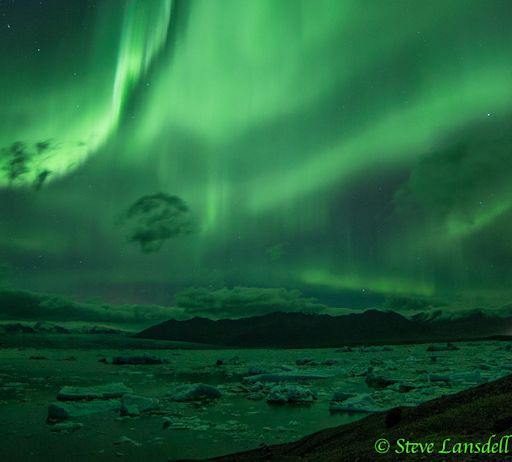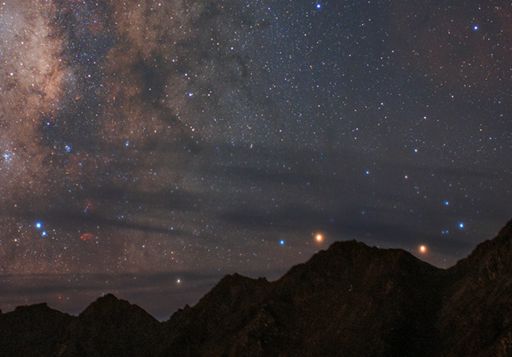When is the best time to see auroras? Where is the best place to go? And how do you photograph them? These questions and more are answered in a new book, Northern Lights - a Guide, by Pal Brekke & Fredrik Broms. | | | FARSIDE ERUPTION: An impressive halo CME billowed away from the sun during the late hours of Sept. 24th: movie. Data from NASA's STEREO spacecraft pinpoint the blast site: It's on the farside of the sun. Earth was not in the line of fire. Solar flare alerts: text, voice AURORA SEASON: How do you know it's autumn in Iceland? It's when the icebergs turn green. Last night, Steve Lansdell photographed the phenomenon from the Jokulsaron Ice Lagoon: 
"We've seen auroras 4 nights in a row, but last night was really spectacular," says Lansdell. "The green lit up the icebergs in a wonderful display that thrilled my friends." These are equinox auroras, appearing less than 48 hours after the onset of northern autumn. For reasons researchers don't fully understand, auroras love equinoxes. At this time of year even a gentle gust of solar wind can spark a beautiful display. Mindful of the season, NOAA forecasters estimate a 50% chance of more polar geomagnetic storms--and more green ice--in the next 24 hours. Aurora alerts: text, voice Realtime Aurora Photo Gallery MARS vs. ANTI-MARS: Shining bright red in the heart of the constellation Scorpius, 1st-magnitude star Antares is often mistaken for Mars. In Greek, "Antares" means "rival of Mars" or "anti-Mars," so-named because it is about the same brightness and color as the Red Planet. As September comes to a close, the rivals are converging. Jeff Dai sends this photo of Mars and Antares setting side-by-side behind Mount Balang in Sichuan, China: 
"I was looking southwest in the evening sky on Sept. 20th when a conspicuous pair of ruddy objects grabbed my attention," says Dai. "Red planet Mars is moving in for a close encounter with its ancient rival, the red supergiant star Antares." On Sept. 28th and 29th, the nights of closest approach, Mars and Antares will be only a few degrees apart, a conjunction tight enough to fit behind your outstretched palm. Sept. 29th is the best night to look because the Moon will join the display, lining up to form a near-vertical column of heavenly bodies just above the southwestern horizon. Sept. 27th is a good night, too, but for a different reason: A slender crescent Moon will pass very close to Saturn not far from Antares and Mars. Sky maps: Sept. 25, 26, 27, 28, 29. Can't remember all these dates? Let Spaceweather.com do the remembering for you. Sign up for backyard astronomy alerts. Realtime Space Weather Photo Gallery
Realtime Comet Photo Gallery Every night, a network of NASA all-sky cameras scans the skies above the United States for meteoritic fireballs. Automated software maintained by NASA's Meteoroid Environment Office calculates their orbits, velocity, penetration depth in Earth's atmosphere and many other characteristics. Daily results are presented here on Spaceweather.com. On Sep. 25, 2014, the network reported 35 fireballs.
(34 sporadics, 1 Southern Taurid)  In this diagram of the inner solar system, all of the fireball orbits intersect at a single point--Earth. The orbits are color-coded by velocity, from slow (red) to fast (blue). [Larger image] [movies] Potentially Hazardous Asteroids ( PHAs) are space rocks larger than approximately 100m that can come closer to Earth than 0.05 AU. None of the known PHAs is on a collision course with our planet, although astronomers are finding new ones all the time. On September 25, 2014 there were potentially hazardous asteroids. Notes: LD means "Lunar Distance." 1 LD = 384,401 km, the distance between Earth and the Moon. 1 LD also equals 0.00256 AU. MAG is the visual magnitude of the asteroid on the date of closest approach. | | The official U.S. government space weather bureau | | | The first place to look for information about sundogs, pillars, rainbows and related phenomena. | | | Researchers call it a "Hubble for the sun." SDO is the most advanced solar observatory ever. | | | 3D views of the sun from NASA's Solar and Terrestrial Relations Observatory | | | Realtime and archival images of the Sun from SOHO. | | | from the NOAA Space Environment Center | | | the underlying science of space weather | | 
